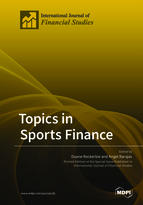Sports Finance 2018
A special issue of International Journal of Financial Studies (ISSN 2227-7072).
Deadline for manuscript submissions: closed (28 February 2019) | Viewed by 60678
Special Issue Editors
Interests: economics of professional sports; economics of higher education; international finance
Special Issue Information
Dear Colleagues,
Sports economics is a relatively new field of research that is experiencing rapid growth in the economics literature. The importance of the sports industry to economies coupled with the availability of financial and productivity data have made the study of sports economics a useful avenue for exploring research questions that have eluded mainstream economics fields. The main goal of this Special Issue of the International Journal of Financial Studies is to encourage theoretical and applied research in sports economics, which is of interest to both academics and practitioners.
For this purpose, this Special Issue on “Sports Finance” invites papers on topics, such as, but not limited to, salary determination, ticket pricing, revenue sharing, salary caps, competitive balance, new stadium financing, rival league behavior, determinants of revenue, television and media, tournament prize structures, financial distress in professional sports, financial fair play, financial control of sports clubs, Third Party Ownership, financial efficiency in professional sports, budget constrains and sport performance, financial information of sports, ownership of professional sport clubs and Crowdfunding in sports. Papers on both professional and amateur sports are welcome.
Prof. Dr. Duane Rockerbie
Prof. Dr. Angel Barajas
Guest Editor
Manuscript Submission Information
Manuscripts should be submitted online at www.mdpi.com by registering and logging in to this website. Once you are registered, click here to go to the submission form. Manuscripts can be submitted until the deadline. All submissions that pass pre-check are peer-reviewed. Accepted papers will be published continuously in the journal (as soon as accepted) and will be listed together on the special issue website. Research articles, review articles as well as short communications are invited. For planned papers, a title and short abstract (about 100 words) can be sent to the Editorial Office for announcement on this website.
Submitted manuscripts should not have been published previously, nor be under consideration for publication elsewhere (except conference proceedings papers). All manuscripts are thoroughly refereed through a single-blind peer-review process. A guide for authors and other relevant information for submission of manuscripts is available on the Instructions for Authors page. International Journal of Financial Studies is an international peer-reviewed open access quarterly journal published by MDPI.
Please visit the Instructions for Authors page before submitting a manuscript. The Article Processing Charge (APC) for publication in this open access journal is 1800 CHF (Swiss Francs). Submitted papers should be well formatted and use good English. Authors may use MDPI's English editing service prior to publication or during author revisions.
Keywords
- Stadium financing
- Competitive balance
- Salary determination
- Broadcasting
- Consumer welfare
- League structure
- Demand and revenues






